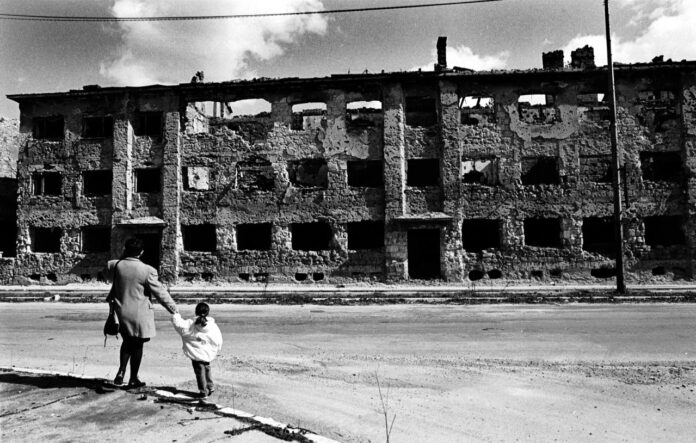“When I arrived in Mostar it was kind of… You know, the goosebumps… So much scarification and destruction,” Isabella Balena tells BIRN from her home in Milan, struggling to describe the feelings she had when she first entered the war-damaged city on the banks of the Neretva river in 1995.
Balena was not new to scenes of destruction. Since the start of her career in 1991, the Italian photographer has documented life in conflict or crisis zones all over the world. Over the course of three decades, she has taken pictures in places such as Iraq, Somalia, Kenya, Sudan, Israel and the Palestinian Territories, Chiapas in Mexico, Albania, Ukraine and Syria.
When she arrived in Mostar, the war in Bosnia and Herzegovina had been raging since 1992 on various fronts. Mostar was one of them. At the beginning of the war, the city was attacked by Bosnian Serb forces, but successfully defended.
By September 1992, another conflict had begun between the Bosniak-led Army of Bosnia and Herzegovina and the Croat-led Croatian Defence Council, HVO, which would continue until March 1994, when the two warring forces signed a treaty, uniting them to fight against the Serbs.
Before the truce, Bosniaks and Croats fought for control over the east and west banks of the Neretva. Even after the ceasefire, the city remained divided between the two sides, with checkpoints on the bridges connecting them.
“I came to document the life of women in the east and west bank of the city together with an Italian cooperation NGO,” Balena recalled. The Italian Agency for Development Cooperation was financing reconstruction and reconciliation efforts in Mostar at the time.
“I continued working with people who suffered injuries from mines… Women, men, children, elderly, mothers, and so on, and so on,” Balena said.
Some 100,000 shells hit Mostar during the conflict, making it the city that suffered the most devastation in the Bosnian war. Balena’s photographs, which take a social documentary perspective, depict the time when the city’s divided people were trying to put their lives back together.
“Time was ‘suspended’ back then. Nobody knew what or how [things] would happen in the upcoming months,” she recalled.
‘Violence was still in the air’
Until 1991, Balena worked as an assistant to famous Italian photographer Gabriele Basilico, who defined himself as “a measurer of space”, often playing with line and light to create a unique perspective.
Balena learned a lot from him. Her photographs from Mostar and the Bosnian capital Sarajevo often look like a carefully-designed movie set.
Coming to Sarajevo after Mostar in the winter months of 1995, Balena was shocked by the cold that gripped the city, which had been under siege from Bosnian Serb forces since 1992.
“But the feeling of being alone in the Sarajevo winter was something I will never forget,” she recalled.
Despite the fact that wartime military operations had almost ended by that time, Balena remembers that the destruction was still palpable.
“The snow was everywhere, you know. But the feeling was like that the violence was still in the air. Just moving through the city gives you the perception of the violence, in the streets and in the air,” she said.
During the war, Bosnian capital was under siege by Bosnian Serb forces from April 1992 until February 1996, when the last units, which had been targeting the city with artillery and sniper fire, had left the hills around the town.
Despite the hills being covered in snow, Balena could see thousands of tombstones on several hillside graveyards, standing witness the death of some 14,000 people in the capital.
“But at the same time, people were feeling that the war is at the end, somehow. There was this slight trace of hope, both in Mostar and Sarajevo,” Balena added.
‘Life continues despite everything’
For Balena, going to conflict zones or places in crisis means giving a voice to people who are silenced by their suffering.
“I feel like it is important to have someone coming to document your life when everything is falling apart,” she said.
“Just having people like me coming to places like this also means having another perspective to your life,” she added.
In the years after the war, Balena never visited Mostar again. But as she continued her assignments in conflict zones elsewhere in the world, she said she saw the story of Bosnia and Herzegovina repeating itself again and again over the years, although in different places.
“Wherever you look, it’s all the same. People dying and suffering. What I saw in Mostar and Sarajevo, I’ve seen also in Syria, Iraq, Ukraine,” she said.
But the most important thing, she argued, is that life goes on – a feeling that she tries to capture with her camera. “You see that in my photos,” she said. “Life continues despite everything.”
Source : Balkan Insight

